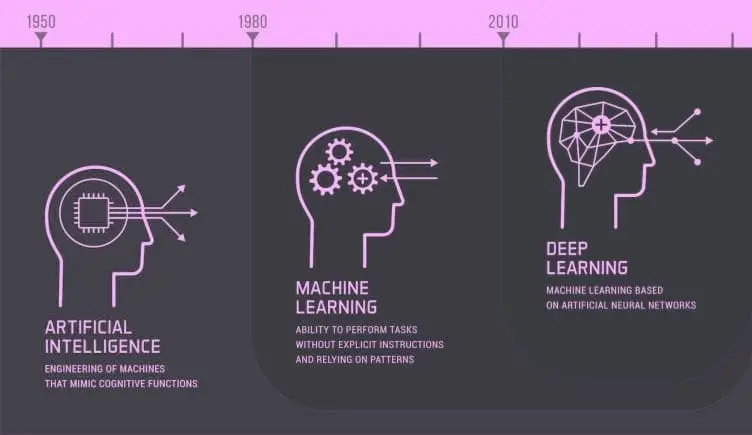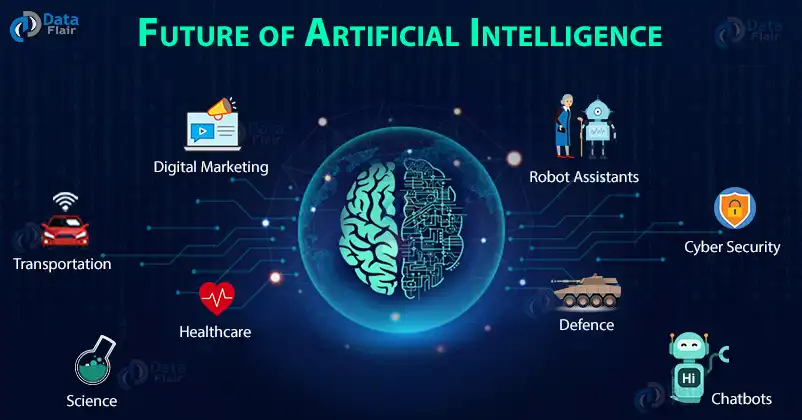AI and machine learning: Its history to its future

In this technology-driven world where every phase of our life includes the utilization of AI and machine learning. Well for sure you once have thought about how in the world where human dominates, AI and machine learning made a place for it. Some people believe that AI and machine learning is one thing. This myth is going to be cleared in this blog. In this blog, we have discussed the history of AI and machine learning in detail. To get complete information, read the complete blog.
Table of Contents
- Machine Learning vs. Artificial Intelligence
- Artificial Intelligence: What Is It?
- Future of Artificial Intelligence
- What is Machine Learning?
- History of Machine Learning
- Future of Machine Learning
Machine Learning vs. Artificial Intelligence
There is a misconception that AI and machine learning are similar terms but actually, they both stand out from each other. Today, the phrase "artificial intelligence" is used more broadly to describe technology that demonstrates cognitive traits similar to those of humans. Generally speaking, AI research is evolving toward a more generic form of intelligence, akin to how young children think and perceive their environment. This could signal the transition of AI from just a tool designed specifically for a particular "narrow" task to one used for "general" answers, like those provided by humans.
Contrarily, machine learning is a specialized branch of artificial intelligence that is limited to algorithms that can continuously develop. Unlike many AI algorithms, which are rigidly programmed for a single goal, they can be enhanced even after being put into use. This not only qualifies students for business applications but also offers a fresh approach to problem-solving in a dynamic context. Deep learning is a subset of machine learning that is a specialized field that contains the key to the development of AI. Neural networks, a sort of algorithm depending on the physical makeup of the human brain, are a component of deep learning. Since neural networks enable a much closer replication of the human mind than has ever been possible, they appear to be the most fruitful direction for AI research going forward.
Artificial intelligence: What Is It?
Artificial intelligence is an amazing technique for teaching a computer, a robot operated by a computer, or software to think critically and creatively like a human mind. AI is achieved by examining the cognitive process and researching the characteristics of the human brain. These research initiatives result in intelligent software and systems.
An Overview of Artificial Intelligence's History
Here is a brief timeline showing how AI has developed over the last six decades since its inception.
In 1956, John McCarthy organized the very first AI conference and created the phrase "artificial intelligence."
In 1969, Shakey, the first versatile mobile robot, was developed. Now it may operate with intention rather than just following a set of rules.
1997 - The former champion chess player was defeated in a match by the supercomputer "Deep Blue," which was created. This large computer was created by IBM, which was a noteworthy achievement.
2002-The first robotic vacuum cleaner to be a commercial success was developed.
From 2005 to 2019, several advancements were introduced, including speech detection, robotic process automation (RPA), a dancer robot, smart houses, and others.
In the initial phases of the SARS-CoV-2 (COVID-19) outbreak in 2020, Baidu makes the LinearFold AI algorithm available to scientific, medical, and medical teams working on a vaccine. The algorithm is 120 times better than prior approaches and can predict the virus's RNA sequence in just 27 seconds.
Future of Artificial Intelligence
People have sought to develop a machine that acts like a person in the post-industrial period. The most major contribution of AI to humanity has been the development of the thinking machine, which has abruptly altered how commerce is conducted. Self-driving cars, communication devices, robotic factory workers, and smart areas have all demonstrated in recent years that smart machines are technically feasible. The majority of industry sectors, including retail, manufacturing, banking, healthcare, and media, have been altered by AI, and it is still expanding.

What is Machine Learning?
A subfield of artificial intelligence (AI) and, computer vision referred to as machine learning, focuses on using data and algorithms to simulate how humans learn, gradually increasing the accuracy of the system
Machine learning is a crucial component of data science, a rapidly increasing field. Data mining operations use statistical techniques to train algorithms to produce classifications or predictions, which reveal crucial insights. Ideally, judgments are taken that have an impact on important growth metrics in applications and businesses. As big data evolves and expands, data scientists are going to be in more demand since they will be required to assist in determining the most crucial business concerns and then gather the data to tackle them.
History of machine learning
Machine learning research has been conducted for many years—almost as long as the history of the electronic digital computer. Researchers at IBM created a checkers-playing algorithm in the 1950s that gradually "learned" which moves led to better results than others. The idea of a "neural network" was being investigated by the 1960s. A computer model of synapses and neurons similar to those seen in the human brain is called a neural network.
It is proposed that a computer may be made to form neural connections like how the brain is thought to do so when learning. Despite years of study and advancements in computing power, findings were mixed at best due to the tiny size of neural networks which can be depicted on a computer (relative to those found in the brain).
By the 1990s, the focus of machine learning studies had shifted to developing methods for making computers capable of processing massive volumes of data to spot patterns and "learn" anticipated outcomes from input variables. For instance, this made it possible for IBM's Deep Blue computer to defeat chess world champion, Garry Kasparov. This strategy was still primarily a brute-force analysis of every result for a specific board position to choose the optimal course of action.
Future of machine learning
Machine learning will soon have a vastly increased range of practical applications if the latest developments in algorithm development and machine performance continue. Deep-learning algorithms are already used to identify objects and language in photos, as well as emotions from facial photographs and other things. Think about these potential future scenarios:
- Autonomous vehicles not only recognize items like pedestrians, vehicles, and animals but also anticipate what they will do
- Sports event "watching," scoring, and reporting" systems
- systems that can identify and stop hacking activities and fraudulent activities, even using previously unknown techniques and flaws
- Robots have the ability to gauge the emotional state and modify how they interact with you
If you have figured out the importance of AI and machine learning in your life and are going to implement its applications in a project, then you might need our help. Labellerr is the right platform for you. We are a data training platform with an experienced team of annotation experts to support you at a higher level. In order to scale your AI and machine learning project, we highly recommend you use high-quality data.
To know more about the World of AI and technology, keep visiting our website!

Simplify Your Data Annotation Workflow With Proven Strategies
.png)


